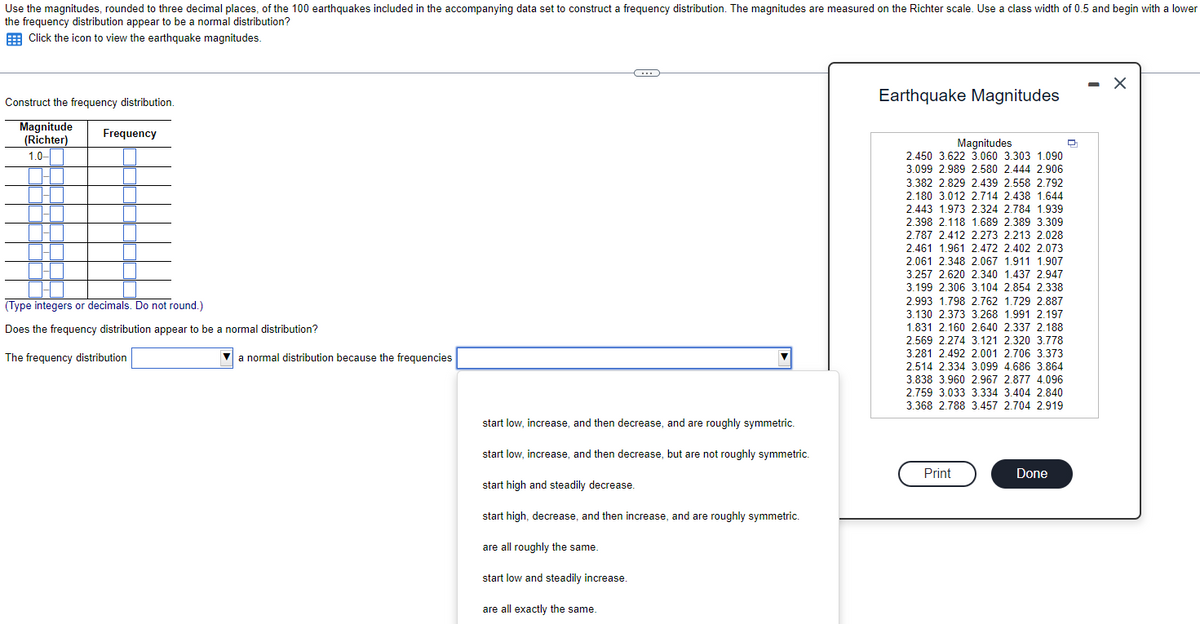Use the magnitudes, rounded to three decimal places, of the 100 earthquakes included in the accompanying data set to construct a frequency distribution. The magnitudes are measured on the Richter scale. Use a class width of 0.5 and begin with a lower the frequency distribution appear to be a normal distribution? Click the icon to view the earthquake magnitudes. Construct the frequency distribution. Magnitude (Richter) 1.0- O 0-0 CH CH Frequency (Type integers or decimals. Do not round.) Does the frequency distribution appear to be a normal distribution? The frequency distribution a normal distribution because the frequencies start low, increase, and then decrease, and are roughly symmetric. Earthquake Magnitudes Magnitudes 2.450 3.622 3.060 3.303 1.090 3.099 2.989 2.580 2.444 2.906 3.382 2.829 2.439 2.558 2.792 2.180 3.012 2.714 2.438 1.644 2.443 1.973 2.324 2.784 1.939 2.398 2.118 1.689 2.389 3.309 2.787 2.412 2.273 2.213 2.028 2.461 1.961 2.472 2.402 2.073 2.061 2.348 2.067 1.911 1.907 3.257 2.620 2.340 1.437 2.947 3.199 2.306 3.104 2.854 2.338 2.993 1.798 2.762 1.729 2.887 3.130 2.373 3.268 1.991 2.197 1.831 2.160 2.640 2.337 2.188 2.569 2.274 3.121 2.320 3.778 3.281 2.492 2.001 2.706 3.373 2.514 2.334 3.099 4.686 3.864 3.838 3.960 2.967 2.877 4.096 2.759 3.033 3.334 3.404 2.840 3.368 2.788 3.457 2.704 2.919 D X
Use the magnitudes, rounded to three decimal places, of the 100 earthquakes included in the accompanying data set to construct a frequency distribution. The magnitudes are measured on the Richter scale. Use a class width of 0.5 and begin with a lower the frequency distribution appear to be a normal distribution? Click the icon to view the earthquake magnitudes. Construct the frequency distribution. Magnitude (Richter) 1.0- O 0-0 CH CH Frequency (Type integers or decimals. Do not round.) Does the frequency distribution appear to be a normal distribution? The frequency distribution a normal distribution because the frequencies start low, increase, and then decrease, and are roughly symmetric. Earthquake Magnitudes Magnitudes 2.450 3.622 3.060 3.303 1.090 3.099 2.989 2.580 2.444 2.906 3.382 2.829 2.439 2.558 2.792 2.180 3.012 2.714 2.438 1.644 2.443 1.973 2.324 2.784 1.939 2.398 2.118 1.689 2.389 3.309 2.787 2.412 2.273 2.213 2.028 2.461 1.961 2.472 2.402 2.073 2.061 2.348 2.067 1.911 1.907 3.257 2.620 2.340 1.437 2.947 3.199 2.306 3.104 2.854 2.338 2.993 1.798 2.762 1.729 2.887 3.130 2.373 3.268 1.991 2.197 1.831 2.160 2.640 2.337 2.188 2.569 2.274 3.121 2.320 3.778 3.281 2.492 2.001 2.706 3.373 2.514 2.334 3.099 4.686 3.864 3.838 3.960 2.967 2.877 4.096 2.759 3.033 3.334 3.404 2.840 3.368 2.788 3.457 2.704 2.919 D X
Glencoe Algebra 1, Student Edition, 9780079039897, 0079039898, 2018
18th Edition
ISBN:9780079039897
Author:Carter
Publisher:Carter
Chapter10: Statistics
Section10.4: Distributions Of Data
Problem 22PFA
Related questions
Question

Transcribed Image Text:Use the magnitudes, rounded to three decimal places, of the 100 earthquakes included in the accompanying data set to construct a frequency distribution. The magnitudes are measured on the Richter scale. Use a class width of 0.5 and begin with a lower
the frequency distribution appear to be a normal distribution?
Click the icon to view the earthquake magnitudes.
Construct the frequency distribution.
Magnitude
(Richter)
1.0-
H
H
Frequency
(Type integers or decimals. Do not round.)
Does the frequency distribution appear to be a normal distribution?
The frequency distribution
a normal distribution because the frequencies
start low, increase, and then decrease, and are roughly symmetric.
start low, increase, and then decrease, but are not roughly symmetric.
start high and steadily decrease.
start high, decrease, and then increase, and are roughly symmetric.
are all roughly the same.
start low and steadily increase.
are all exactly the same.
Earthquake Magnitudes
Magnitudes
2.450 3.622 3.060 3.303 1.090
3.099 2.989 2.580 2.444 2.906
3.382 2.829 2.439 2.558 2.792
2.180 3.012 2.714 2.438 1.644
2.443 1.973 2.324 2.784 1.939
2.398 2.118 1.689 2.389 3.309
2.787 2.412 2.273 2.213 2.028
2.461 1.961 2.472 2.402 2.073
2.061 2.348 2.067 1.911 1.907
3.257 2.620 2.340 1.437 2.947
3.199 2.306 3.104 2.854 2.338
2.993 1.798 2.762 1.729 2.887
3.130 2.373 3.268 1.991 2.197
1.831 2.160 2.640 2.337 2.188
2.569 2.274 3.121 2.320 3.778
3.281 2.492 2.001 2.706 3.373
2.514 2.334 3.099 4.686 3.864
3.838 3.960 2.967 2.877 4.096
2.759 3.033 3.334 3.404 2.840
3.368 2.788 3.457 2.704 2.919
Print
Done
Q
X
Expert Solution
This question has been solved!
Explore an expertly crafted, step-by-step solution for a thorough understanding of key concepts.
This is a popular solution!
Trending now
This is a popular solution!
Step by step
Solved in 3 steps with 3 images

Recommended textbooks for you

Glencoe Algebra 1, Student Edition, 9780079039897…
Algebra
ISBN:
9780079039897
Author:
Carter
Publisher:
McGraw Hill

Big Ideas Math A Bridge To Success Algebra 1: Stu…
Algebra
ISBN:
9781680331141
Author:
HOUGHTON MIFFLIN HARCOURT
Publisher:
Houghton Mifflin Harcourt

Holt Mcdougal Larson Pre-algebra: Student Edition…
Algebra
ISBN:
9780547587776
Author:
HOLT MCDOUGAL
Publisher:
HOLT MCDOUGAL

Glencoe Algebra 1, Student Edition, 9780079039897…
Algebra
ISBN:
9780079039897
Author:
Carter
Publisher:
McGraw Hill

Big Ideas Math A Bridge To Success Algebra 1: Stu…
Algebra
ISBN:
9781680331141
Author:
HOUGHTON MIFFLIN HARCOURT
Publisher:
Houghton Mifflin Harcourt

Holt Mcdougal Larson Pre-algebra: Student Edition…
Algebra
ISBN:
9780547587776
Author:
HOLT MCDOUGAL
Publisher:
HOLT MCDOUGAL